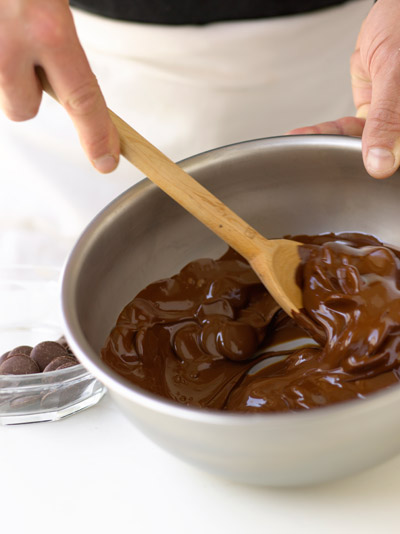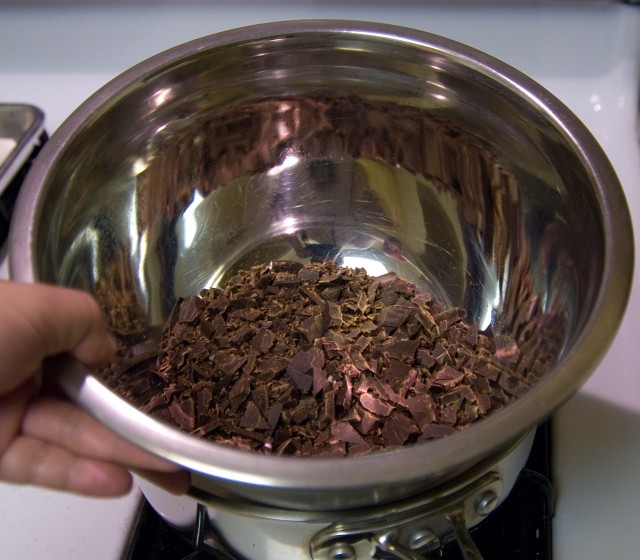TECHNIQUES IN CHOCOLATE
May 20, 2013
The first day of chocolate class was awesome! I really like the Chef and his teaching style. I think I am going to enjoy this class. He has a great sense of humor and has already handed out chocolate for us to nibble on while he taught us. How great is that? Although this class should be fun, it will definitely be a challenge for sure. We will be doing chocolate confections, a showpiece, frozen desserts and plated desserts along with a molecular gastronomy lab.
 This week we are covering tempering chocolate for the entire week. Apparently this is quite difficult as it is an exact science and most individuals cannot temper chocolate properly. I can attest to this as I have tried before after reading and watching videos and was unsuccessful at it. After this course though, I should have it down as we will be doing quite a bit of it for the next 6 weeks.
This week we are covering tempering chocolate for the entire week. Apparently this is quite difficult as it is an exact science and most individuals cannot temper chocolate properly. I can attest to this as I have tried before after reading and watching videos and was unsuccessful at it. After this course though, I should have it down as we will be doing quite a bit of it for the next 6 weeks.
 The purpose of tempering chocolate is that if it is not tempered the fat (cocoa butter) in the chocolate will bloom (a white discoloration on the surface) and the chocolate would feel oily and melt when it is touched. None of this means the chocolate is bad or tastes bad, it is just less appealing to look at and messy to touch. The white discoloration on the surface is made up entirely of cocoa butter that has re-solidified in an undesirable crystal form. It can be fixed by simply re-tempering the chocolate properly. Well tempered chocolate will have good snap, will retract, and have a permanent shine.
The purpose of tempering chocolate is that if it is not tempered the fat (cocoa butter) in the chocolate will bloom (a white discoloration on the surface) and the chocolate would feel oily and melt when it is touched. None of this means the chocolate is bad or tastes bad, it is just less appealing to look at and messy to touch. The white discoloration on the surface is made up entirely of cocoa butter that has re-solidified in an undesirable crystal form. It can be fixed by simply re-tempering the chocolate properly. Well tempered chocolate will have good snap, will retract, and have a permanent shine.
One of the keys to tempering chocolate is to warm the chocolate slowly to the correct melting temperature without going past the appropriate temperature (within 2 degrees). Each of the chocolates (dark, milk, and white) have a different specific melting temperature (118, 106 and 104 respectively) and tempered temperature (89, 86, and 84).
 There are 4 different methods for tempering chocolate (seeding, block, microwave, and table). We will be learning each of these methods, although microwave is not really considered tempering the chocolate and if you mess it up, you have to temper by one of the other tempering methods.
There are 4 different methods for tempering chocolate (seeding, block, microwave, and table). We will be learning each of these methods, although microwave is not really considered tempering the chocolate and if you mess it up, you have to temper by one of the other tempering methods.
 We have already been tasks with several challenges for this class. The first is that our chef jackets and aprons are to remain clean without chocolate on them. Keep in mind these are both white. I already know that this will be quite difficult based on my experience in the Intro to Baking class and we did not even work with chocolate every day in the kitchen.
We have already been tasks with several challenges for this class. The first is that our chef jackets and aprons are to remain clean without chocolate on them. Keep in mind these are both white. I already know that this will be quite difficult based on my experience in the Intro to Baking class and we did not even work with chocolate every day in the kitchen.
Second, we are not to use the word "heat" with the word "chocolate" in the same sentence. Heating chocolate is bad, warming is good. Myself and several others in the class have already broken this rule while asking questions. Today we were give a pass but I think he said he would be deduct points after today.
 Third, we will be memorizing different formulas and ratios throughout the course. Today was Ganache, yum. We are to memorize the following ratios for Ganache:
Third, we will be memorizing different formulas and ratios throughout the course. Today was Ganache, yum. We are to memorize the following ratios for Ganache:
Dark Chocolate: 1 part cream - 1 part chocolate
Milk Chocolate: 1 part cream - 2 parts chocolate
White Chocolate: 1 part cream - 3 parts chocolate
If the chocolate ratio is more than the cream, always melt the chocolate first.
Fourth, if you have perfect attendance, you do not have to take the final written exam. I am all for this one!
 After making molded candies yesterday, we moved on to other chocolate confections such as truffles and candied orange peel. My team was assigned to make marshmallow. This was a good learning experience for me as I completely messed up the first batch and had to make it over again.
After making molded candies yesterday, we moved on to other chocolate confections such as truffles and candied orange peel. My team was assigned to make marshmallow. This was a good learning experience for me as I completely messed up the first batch and had to make it over again. What I learned was that you beat the egg whites with only a little bit of the granulated sugar. I poured all the granulated sugar into the egg whites. This does not allow the egg whites to whip up to the proper consistency. Also the formula required water and sugar be heated between 240 and 265 degrees. I put the corn syrup in the water and heated the mix. Without having any of the granulated sugar in the water mixture, the mixture simply just boiled down and would not reach the required temperature.
What I learned was that you beat the egg whites with only a little bit of the granulated sugar. I poured all the granulated sugar into the egg whites. This does not allow the egg whites to whip up to the proper consistency. Also the formula required water and sugar be heated between 240 and 265 degrees. I put the corn syrup in the water and heated the mix. Without having any of the granulated sugar in the water mixture, the mixture simply just boiled down and would not reach the required temperature.  Second time round, a small amount of sugar went into the egg whites, the rest into the corn syrup, water mixture and everything turned out great in the end. It tastes just like the marshmallows bought from the store.
Second time round, a small amount of sugar went into the egg whites, the rest into the corn syrup, water mixture and everything turned out great in the end. It tastes just like the marshmallows bought from the store.  I also was able to work with gelatin sheets, which I have never used before. These were soaked in water for 5 to 8 minutes and then once the sheets absorbed the water, the water was squeezed out by hand and added to the egg white, sugar syrup mixture.
I also was able to work with gelatin sheets, which I have never used before. These were soaked in water for 5 to 8 minutes and then once the sheets absorbed the water, the water was squeezed out by hand and added to the egg white, sugar syrup mixture. 







































